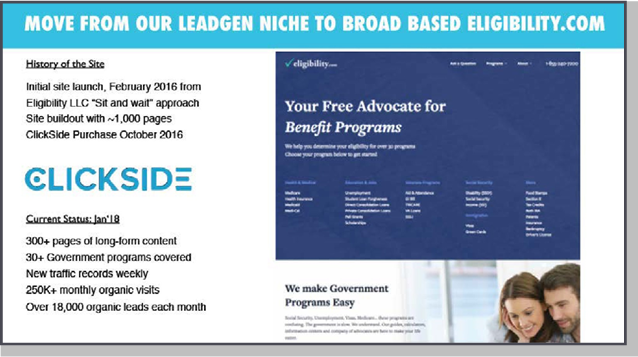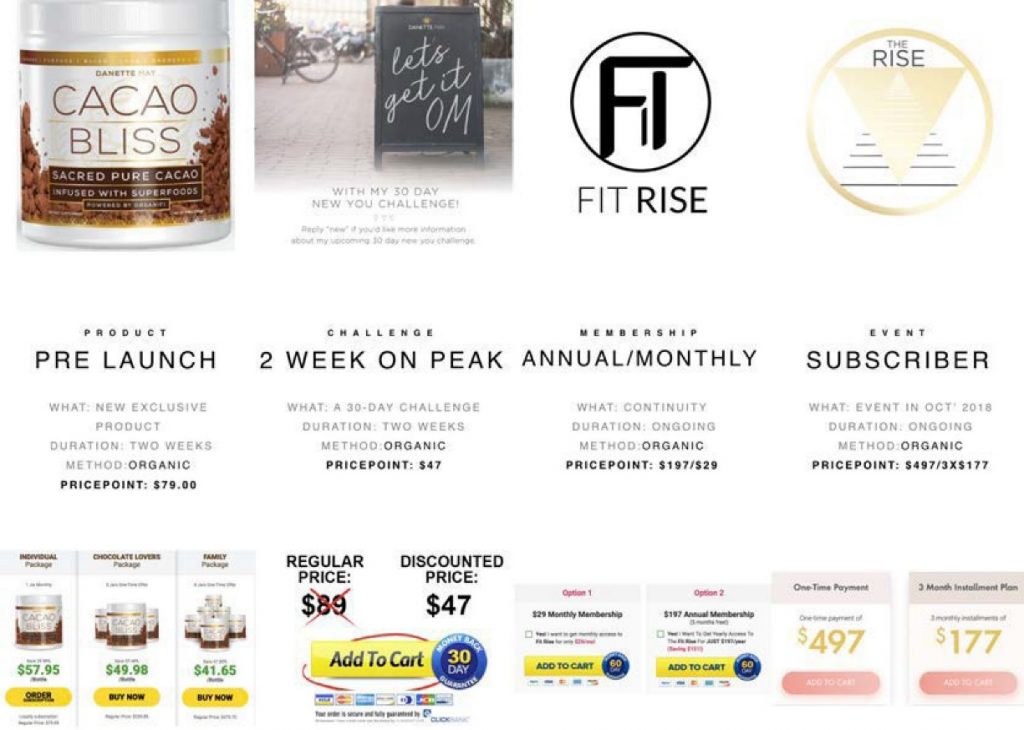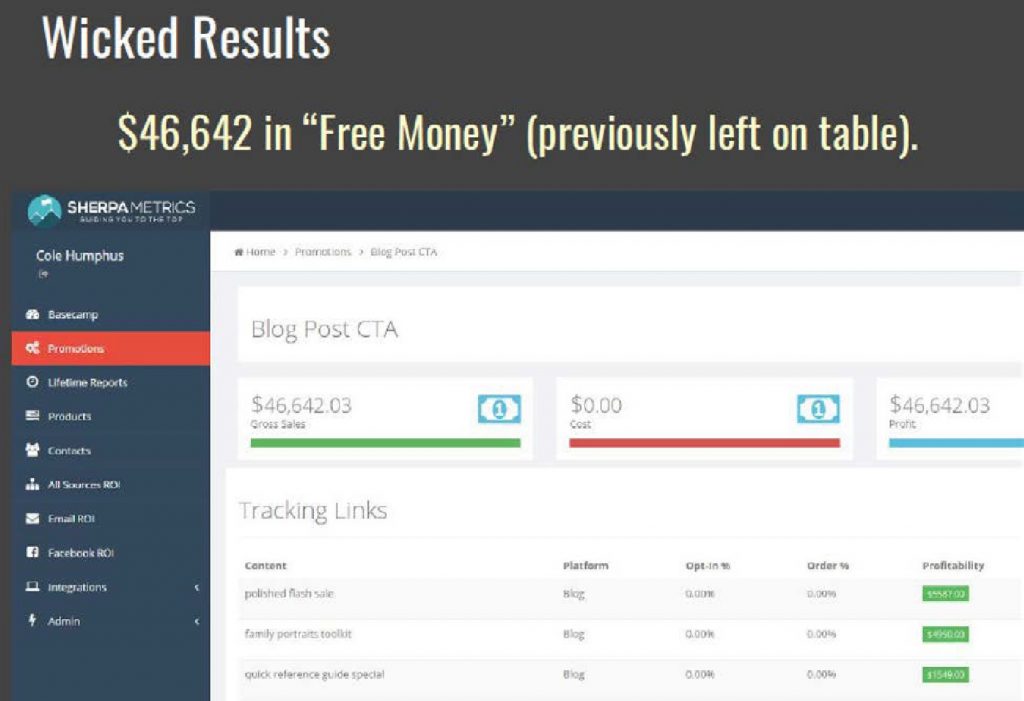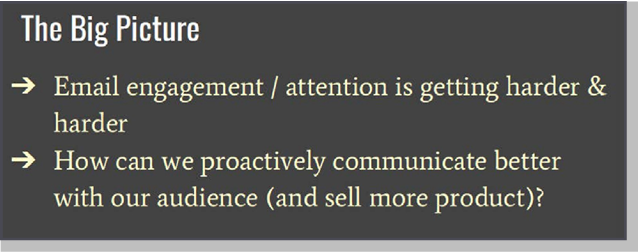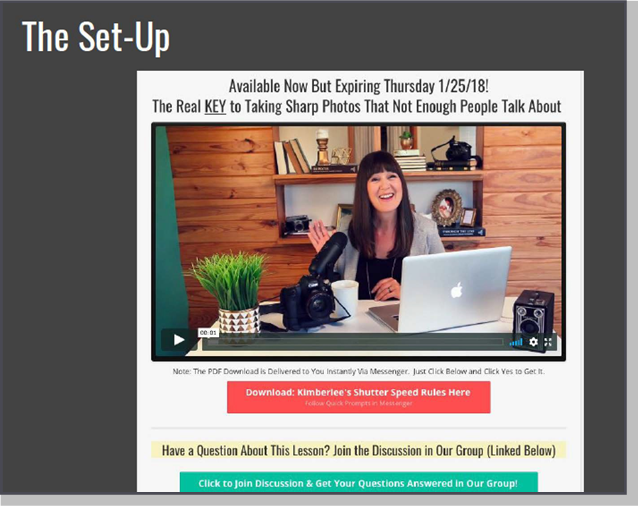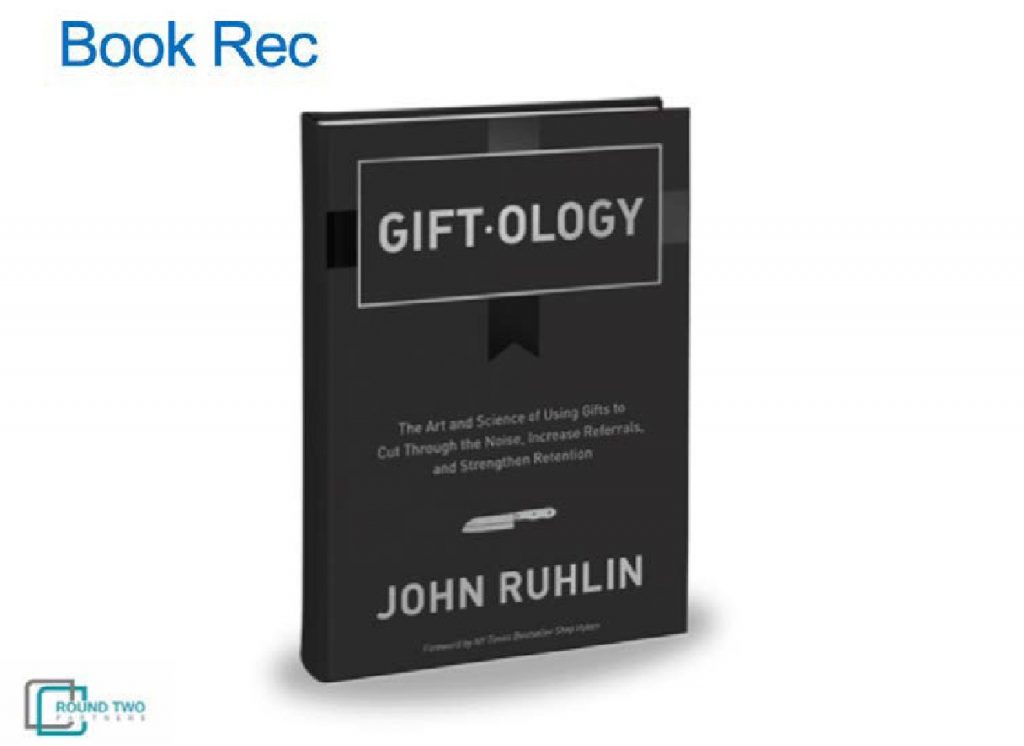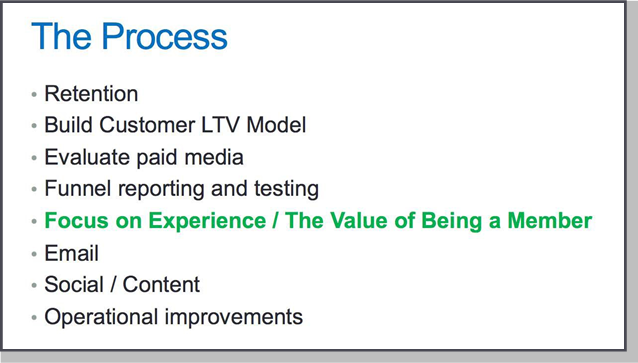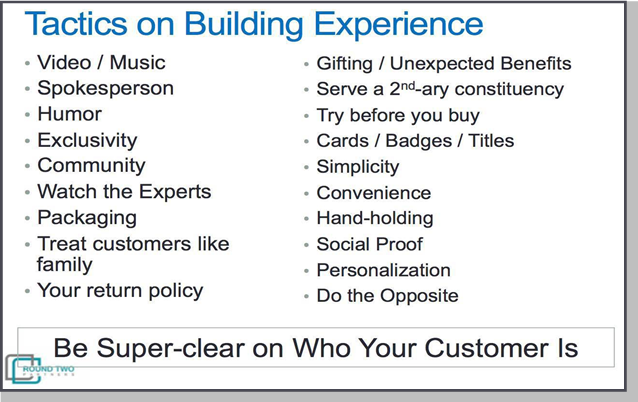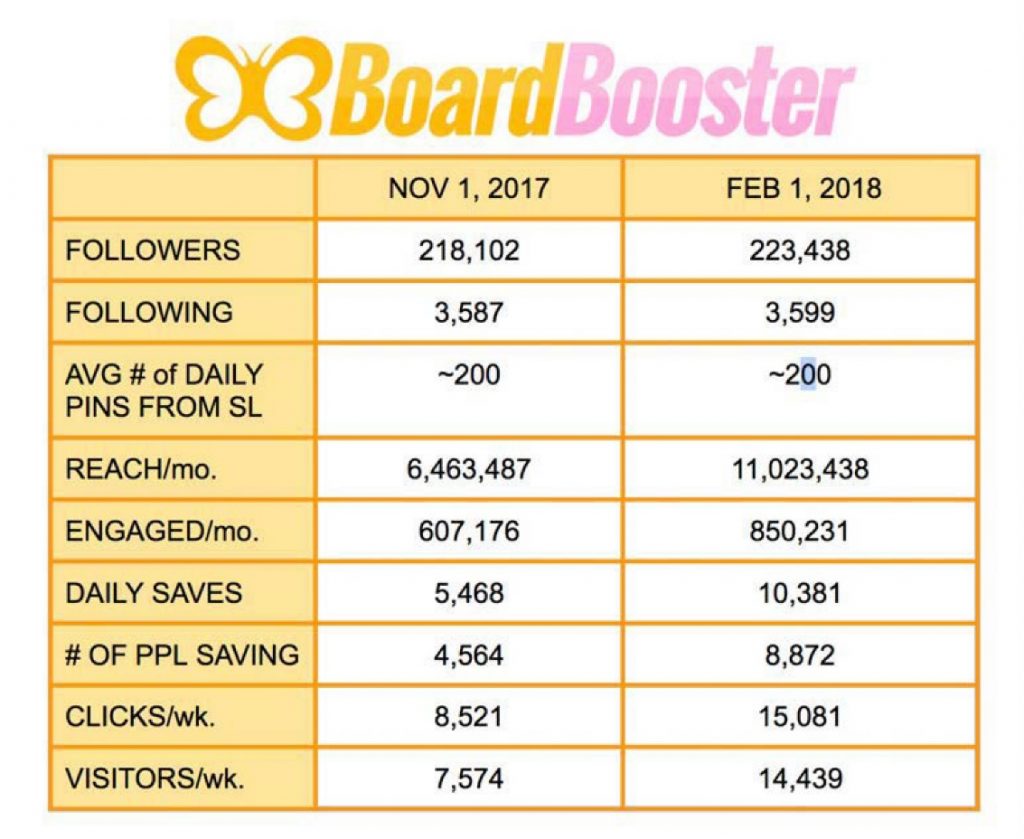Roland Frasier
Roland currently is a principal in Idea Incubator, which owns both DigitalMarketer.com and NativeCommerce.com and works in marketing businesses as a principal with Ryan Deiss, Perry Belcher, Frank Kern and many other digital marketing thought leaders. Roland has a real passion for business and putting deals together and is always on the lookout for businesses to buy, reposition and sell.
Welcome to the Wicked Smart Session of Traffic & Conversion Summit. This is one of our favorite things that we do. We have a mastermind called War Room, and the favorite, most popular session in War Room is always Wicked Smart.
So Wicked Smart is where everyone gets together and submits the thing that is working best, that’s the coolest in their business to deliver the greatest results. It’s the no bullshit, no ideas kind of thing, only proven things that work that other people can do.
So we’re bringing that here from War Room to you guys so that you can have that experience too because there’s so much brilliance. We want to a share it with you guys.
The deal with Wicked Smart is it has to be something that you’ve done,
and you have to lead with, “Here is my Wicked Smart. Here’s what happened. Here’s how I did it, and here’s how you can do it.” That’s why this is so powerful.
I love that we have these eight Wicked Smart people. We’re going to step back, step out of the way, and let them start sharing their Wicked Smart results with you.
Dave Parkinson
I’m Dave Parkinson. I’m with Adduco Media and Clicks On Media.
Dave’s Wicked Smart: My Wicked Smart is focused around organic search, as well as push list optimization and monetization.
The Result: Our result was we took 3,000 visitors a month to our portal Eligibility.com to just over 250,000 organic visitors a month. And we took a push list of zero to over 30,000 and monetized it to the tune of seven figures across different assets.
The site was initially launched with 1,000 pages of content. It was not long- form content. We purchased the site from the original owner with those 1,000 pages, and we went to work. We bought the site back in October of 2016, which was just about 18 months ago, and this is the current status in January 2018.
- We have 300 pages (We took the 1,000 pages down to 300 pages of long-form content).
- We covered 30 government
- We’re hitting new traffic records weekly – Back in December, we were hitting right around a 100,000 organic In February, we’ll hit just over 300,000. So we’re on track to hit over 3 million organic visitors on the site Eligibility.com, which is generating around 18,000 organic leads.
How He Did That:
We have an asset development playbook, and we leverage tools such as MarketMuse and Nozzle and several data sets from our own internal database to build a backlink profile that was recognizable to Google, saying that we were the authority that we were saying we were.
All of our content you’ll find in our main categories is 4,000 plus words, and those are the program pages. We have a 90% success rate on targeting and are ranking top three for those keywords. And we did it very specifically with a content rank backlink strategy.
I’ll explain that real quick. Here are the metrics:
You can see when we got it back in October of 2016, it wasn’t quite on the radar for any of these third party tools. January 2018, we ranked for over 83,000 keywords and have over 150,000 organic visitors.
MarketMuse is a large portion of how we do our content. Nozzle is the rank tracker that we use.
Here’s one key hack that I would tell everyone to focus on: Too often we tell you not to focus on rankings, and it’s important, but if you’re not focused on multiple rankings right now, you’re not going to win this game. It is a mobile world for Google, and they will force that upon all of us. So one thing that we did that I would say to obsess on right now is top three positions for mobile. I don’t care about that stuff, but focus on those rankings for mobile.
Then focus on your backlink profile. Yes, you do still need to be building backlinks. We do that with a company of ours called Spread Effect, and we’ll show you why. Here’s the actual analytics:
Again, going from 3,000 visitors a month in October 2016 to over a 120,000 last October.
Key Takeaway From Backlink Profiles: Focus on topical, relevant backlinks the same way that MarketMuse and these tools teach you how do it on your content. And that focus will drive an overall strategy that gives your customers the best content they want, as well as Google.
And for us, a unique angle was that we knew that states often manage their own federally regulated programs. They couldn’t handle the resource side, so they lacked on those resource guides.
If you look at our top competitors, all the third-party tools say, “Hey, your top competing domains are Benefits.gov, California.gov, NewYork.gov, New Jersey.gov.”
All of those government entities that you would typically say you can’t outrank, that is what our backlink profile says we’re competing against because we use products like MarketMuse and Spread Effect to point topically relevant backlinks back to the site.
Power of the Domain
We launched a page 60 days later: criminal record expungement, and we ranked number one. Word count is our first metric, and then we have a content score where we build internally off of those three different products: MarketMuse, Spread Effect, and SEMrush. We bring all those in and you can see that up against FindLaw, again the California court system, Wikipedia, NOLO, they’re all more powerful domains than we are, but it doesn’t matter.
We rank number one, and what did it produce? Well, in the last 60 days, we produced over 1600 organic leads for those attorneys.
Why did we get all the extra traffic? Why did we focus on relevant click-through traffic? Because we wanted to become an authority.
We generate our leads in very certain programs. The rest of the programs we don’t actually use. You saw unemployment. You saw Medicaid. You saw programs we don’t use that get traffic, but it was important to get those signals. Those people had a need, and that’s how we built the site up.
What do you do with it? You do push notifications. That’s the traffic, whether you’re an e-commerce business, media shop, it doesn’t matter. Don’t do this. Those are all my push notifications I’m getting on the right while I’m being asked to join a push list as well as a chat on site. Don’t do this.
We use PushCrew for our push notifications. You could also use OneSignal if you have developing power.
One Tactile Hack on the Push Side: Start to pay attention to what the big companies are doing. Any of you guys that want to market to Facebook marketers, use that image right there. See that little green check box? Get them opted into your push list and then put it on. This is going to drive your push through the roof.
Tools. It does matter what tool you use. We use PushCrew because we can treat push notifications like Ryan Deiss, with email or chat box.
We can segment. We can do automation campaigns. We can do basically anything our hearts desire. If they click on a YouTube video, and it interacts with an element, great. Opt them into a list that sends out push notifications over the next several days. If they abandon the cart, great. Set them up on an automation campaign that then tries to get them back into that cart.
If you want to see two people who are doing this and are making it work, segmentation and automation campaigns around push notifications, check out our site, Eligibility.com. Visit different program pages and I’m going to put you into different segmented lists.
Visit MarketBeat.com. Same result. On Eligibility, we have over 40,000 push opt-ins. MarketBeat is over a 150,000.
Anna Selby
My name is an Anna Selby. I am the Founder of Pretty Witty, and I am also the Director of Social Media for Mindful Health. Mindful Health, if you don’t know, is the Danette May brand. So if you really want under the hood of what we’re doing, go to all of Danette May’s social channels. You can see all of our work.
Her Wicked Smart Idea: We are organically capturing avatars using our social media channels, which all of us are doing.
How She’s Winning: We’re actually converting through connection conversational converse using a bot. And we’re converting at a pretty high rate.
How Did She Do It: We use a proprietary process that I refer to as “Ting Tang Walla Walla Bing Bang.” I’m not going to break it down because I only have like five minutes. Just know if you scan this code or this link, I have the details there.
Why is This Wicked Smart? In a matter of one month, and we’re able to duplicate this every month, we’re able to not only capture the avatars, but convert them as well. Here are the results:
To dig a little deeper: What are we doing on our social pages? We’re actually marketing four completely different products, programs, events, and continuity programs at once. And we’re not confusing our audience. We’re actually converting at a higher rate.
On an organic social media channel, wouldn’t you like these results? 46,000 units on just a subscriber. So overall, we’ve been able to sell in one month and convert 50k in units, an excess of $150k in revenue. Again, this is organic, no ads spend, and we have a list dedicated and tailored to 60,000 subscribers. Is that something you guys are interested in? Yeah? OK. We’re going to dive into this and I’m going to do it super quick so hang with me.
All right. Our avatar. It’s really important that you identify your avatar. So we use social organic and our avatars are females 34 to 54. We know their behavioral targets, using our bots through the walla walla, they’re lonely, they’re seeking weight loss solutions. And these are the stats from December 1 to January 1.
These are the four different product points. We did a product prelaunch on something called Cacao Bliss. This is an exclusive product. It’s a boutique product with a price point of $79.
At the same time, we did a two-week promotion in December. If you guys are familiar with us, we do an awesome 30-day challenge. We ran that with a price point of $47.
Now, at the same time, we were still marketing and trying to attract individuals into our continuity program. That’s our Fit Rise membership. We were selling this on an annual and monthly basis.
So we were offering both, and then, as if it couldn’t be enough, we’re getting ready to launch an event in October. We started pre-launching and seating this event in December using bots.
We Start With Ting Tang: Now Ting Tang is what I refer to as the front-end marketing. It’s your post, it’s your edge piece, it’s your video. I kind of separated it so you could see what customer journey looks like on a social post. For Cacao Bliss, we use edge pieces like recipes or video stories.
The big thing I want you to focus on is the common CTA that we align with every product on our social platform. The reason we do that is for brand impression. This is a neuromarketing hack, if you will. They’re unknowingly seeing that, and they know “give me bliss” is Cacao. They’re saying yes to our challenge and so on.
I gave you post structure so you have an idea how to format this. We don’t do it any different. How does this look on the front end? If you run down the bottom, what they’re seeing is the brand impression of each individual journey. We’re attracting them in.
This Brings Us to the Walla Walla: Remember that CTA I shared with you? When that user sees that CTA in the comments below, it cues the bot into a dedicated automated journey to that product.
So we have attracted that user. They go into the bot, and now you can see the individualized journey points that we use.
The biggest thing that I can share with you: When using personalization in the bot, introduce the product like it was your friend at a dinner table, survey them using behavioral input triggers, and then follow up.
The tool that we use is Chatkit. This is what the conversation looks like – conversational commerce for each individual journey. I know it’s kind of small.
We Use Input Triggers When We Do Our Journeys: We input on a variable. What does that mean in conversation? If our intention is to sell the product, we basically reverse engineer that journey and we weight time, mood, and the delivered day. The reason we do that is so we can determine when that product is going to convert higher based on what that avatar is sharing with us. They tailor all of our journeys because we’re asking for feedback through the entire process.
Now, there are the results again. If you want to see results on an individual level, you can go ahead and cue into that, and I have a downloadable.
Nicholas Kusmich
Nicholas’ Wicked Smart: What I’m about to show you is where the vast majority of $80 million worth of sales in the last 18 months came from.
Now, technically when we run Facebook ads, we’re typically running a lead generation play up front. Facebook’s great for generating leads. We like that more than generating sales on the front end. But what is a better lead – a warm lead or a cold lead?
A warm lead, or an endorsed lead, is going to be way better than a cold lead. It’s going to cost half as much and probably get us double the results. We’re generating leads at half or less than cold lead generation.
How We Did It: We are going to JV partners, affiliates, friends, anybody in our industry who says, “I like what you’ve got. I want to promote it to my people, but I’m too lazy to send an email, and I’m too lazy to do any work for you. Can you help us out?” Absolutely.
Wicked Smart Tip: You’ve got to get advertiser access to their fan page. And here’s the play: You run all the ads from your actual ad account. You’re flipping the bill. You’re covering all the spend. But you’re running them from the source of your JV partner to their fans or to their email lists, using their affiliate link. They win because they get paid, you win because you get paid, and you’re acquiring leads at half the cost.
Let me just show you what this looks like. It’s the same ad, but now it’s coming from various influencers to their actual page. So this is the cold ad. Simple copy and image. It’s all promoting the iThrive series, which I think is a great series, but, again, cold ads generating leads at $5.15 right now.
However, the same ad coming from influencers to their own audiences with their affiliate links. Now this is coming from TheDoctor.com. This is same ad coming from Mastering Diabetes. The same ad, but look at the language.
It says, “Our friends at iThrive are holding this great thing and we think you should join in.” And as soon as you follow an influencer and that influencer endorses something, you are much more likely to A, opt in at a much higher rate, much lower cost, and, B, convert on the backend at a much higher rate.
So now if all of the influencers and all the friends you’ve called on say, “Hey, can I just run this from your ad account?” Use the same copy, same image, and it just comes as an endorsement from them to their fans and a custom audience of their email list.
All of a sudden what you are going to see is half the cost of the leads that you’d be paying on cold, double the conversions, and you mass blanket the industry so everybody is talking about you, and the momentum that is built from that leads to phenomenally better results.
Cole Humphus
My name is Cole Humphus, and I’m local here in San Diego. And my main business is Cole’s Classroom. We teach photography online.
You’re going to see a sneak peek of our analytic software called Sherpa Metrics. We’re going to make a whole lot of extra money without doing much more work. If you’re like me, that’s a really, really good thing.
Cole’s Wicked Smart: He made an extra $110,937 without spending one penny on ads or launching any new products.
So the big picture is most of us have a lot of really great content. And we have a lot of great products but we’re always sort of in one of two modes:
- We’re either in launch mode
- We’re in promotion mode
And that can be very difficult. And then I had a thought:
So big test number one was to add a simple P.S. to every single piece of content that I put out. So when I’m nurturing, I’m still selling but with a very indirect way, and it looks like this:
And the disclaimer here is a lot of times we think that some of the best ideas can sort of be the simplest, right? And that’s what happened here. So you can see it just says, “Hey, here’s a free tutorial.” And then at the bottom, “Hey, if you still aren’t getting it or want a little more help, check this out.”
So here’s the Wicked results:
That’s $64,393 in free money because I was leaving it on the table for the previous two or so years.
What’s Important Here: You have to be able to have some tracking. You have to know if this stuff’s working, and, if you have multiple offers, which thing is working really well? So that’s, of course, my tool Shepra Metrics. So you can see I’m not lying. Those are the real numbers.
Bonus Trick: Inside the software, whatever you’re using, tag the people that click, and then now you can retarget them on Facebook with ads for even more sales.
Test #2: I said, “Well, if that worked, why don’t we go ahead and do it on the actual blog, not just in the email?” So we added a simple call-to-action on every single blog post. This is what that looks like:
So, once again, it’s relevant, but it’s not sleazy and it’s not in their face. There’s another $46,000 that I picked up that I wouldn’t have had. So between those two things that’s the $119,000.
Now, what tools do you need to do this? Obviously not a whole lot:
- You need your website.
- You need your email list.
- You need to have some tracking and metrics, whatever tool of choice it is for you. Of course, I’m biased, and I use Sherpa Metrics, our tool
- And, of course, we all have content and the product.
Key Takeaway: Don’t ever think that everyone who’s visited your website knows all of your product offerings. A lot of us think, “Well, of course they’ve seen it. It’s in my shop.”
People need multiple touch points before converting, so you’re leaving a ton of free money on the table if you’re only giving people a chance to purchase during that promotional period. And since this is all sort of value first, we’re doing this in that nurture step. It’s nothing to feel weird about, so you’re
still able to just keep giving content, content, content. But then those little incremental dollars add up to a lot.
Mindset: You know there’s always going to be some percentage of people that are on the sales page that will want to buy or want what’s next.
You really want to make sure that not only did it work and how much did it work, but what products are working better than others? Not all of mine are winners, trust me.
And, like I said, a lot of something little can really add up to a big dollar amount at the end of the day. And, of course, we want to make sure your offer is as congruent as possible to the free content.
This is a graph of ManyChat. And, if you guys like the look of that graph, let me know and I’ll show you how I did that without spending any money on ads.
This just happened a couple months ago, and I’m going to show you how I did it. So, here’s how I grew my messenger list from 2523 people to 7718 and made an extra $19,000 or so on my last product launch.
So big picture, we know that email engagement and attention is getting harder and harder. But how we can proactively communicate better with our audience and sell more products?
All right, so here’s the idea – I did this as a launch. A lot of us know the product launch formula. You have sort of that three-part video series that everyone does. You have sort of a freebie-type offer.
So, instead of just giving that freebie, we said, “Hey, download my thing right here.” That opened up into Messenger and said, “Hey, do you want this freebie?” They said yes. That’s an opt in. Now I can communicate with them on Messenger, and you can even tag them so you aren’t blasting your entire Messenger list, but only people that just opted in, so to speak.
So here’s how it looks- there’s our video. There’s the big button that says, “Download the guide here.” And I put a note that said it’s delivered via Messenger, so basically be on the lookout for that.
“Hey there, Cole. Are you looking for the download? If so, click ‘yes’.” You have to do that in order to have permission to go ahead and keep talking to them.
Here’s the Results: We went from 2500 to over 7700. Literally I sent two emails to the list. Easy as it gets, right? 28-50% click-through rate. We
all know that everyone likes to talk about the open on Messenger, but I like clicks, and that was an extra $19,000 in profits.
Here’s the Proof: Once again, this is from Sherpa Metrics. We can see how much came from Messenger from each one of the messages we sent.
And the other piece is not just focus on email lists. So not only was I using Messenger, but I was also getting people into a Facebook group during that pre-launch, and that’s how much money came in from there, as well.
And this the what it looks like if you wanted to see the backend. You can see that we’re only sending this out to people that had opted in. Not the whole list, and there’s the fun, little, awesome-looking chart.
Key Take Away: Do not rely on just one communication channel, especially email. It’s absolutely getting harder and harder. Figure out how to create a new asset list so you can continue to have that other touch point and way to communicate. And definitely figure out ways to leverage things that can give you a greater open or click rate.
Babak Azad
Hi, my name is Babak Azad. I basically work with brands helping them build their performance marketing businesses and working on their customer experience. I spent eight years at Beach Body managing media and customer acquisition, and then for the last few, left and basically worked with clients.
So, I’m going to distill in five minutes a 5,000 word blog post that I wrote, but focus on two key areas. And I have a link to it. There’s no opt-in, none of that stuff. I firmly believe that everyone is in the subscription business. This is basically a process that I use when I work with clients.
So first thing, I know people generally like a book. A lot of people read this. I have no affiliation directly with John, but this has been a game changer for how I look at my professional life, my clients, and my personal life. It’s a phenomenal book. It’s basically 150 pages. You’ll get through it. I’ll be shocked if you don’t get a lot of value out of it.
This is the Process: Generally speaking, when I work with clients, what I do is understand what their retention is and what their stick rate is. That builds into a custom relative model. Ultimately, it’s a progression about what’s going on with your business today. What’s the value of a customer? How are you managing paid media?
We do some stuff in-funnel, and then customer experience, and then we get to email, social, things like that.
So it’s really the process around how I work with folks and what I’ve seen and pulled from a lot of other people. It’s about a better way to actually dig into a business – understanding what the key levers are and then working to optimize.
Retention: For some of you, this will scare you. For some of you, this is actually what you wanted. And for others, I’ll just explain what it is.
The Real Key: What is the value of a customer? And what happens for people who come in through different cohorts? How long do they stick around?
So let’s say your customers come in January, February, March. What percent of them stick around month one, month two, month three, month four? And then the filters at top are basically just something out of Excel, but it’s the different ways to slice and dice the customers. So is it by traffic source? Is it by offer? Is it by promo? By frequency?

This was a subscription box business. But the basic idea is a lot of folks I work with don’t understand this. They don’t know when a customer comes in by, let’s say January, February, March how long do people stick around and then what are those customers worth?
So, basically, I think one of the best investments you can make in a business and (obviously, I’m biased because I come from this background) is to hire an analyst. That may be someone part time. It may be a full-time person. It may be a college kid, but just someone to dig in. Whether it’s on Shopify, Infusionsoft, or whatever the system is, there is a way to dig in and find out what is going on with your customers.
And this is a very basic report, and whether you’re a million dollar business, thousand dollar business, or a billion dollars, this is one of the key things to actually understanding what’s going on in the business today.
I’m going to jump through and get to customer experience. When people come to me and they say, “I want to scale the business.” It’s always a metric. It’s, “I want to hit 10 million, 100 million.” It’s a number, as opposed to what are you actually trying to do and build in your business.
And I would argue that if you actually focus on building a brand – that is where you actually get scale. So, that’s not a marketing hack. That’s not a Facebook ad. That’s not a funnel. That’s not an auto-responder sequence.
Someone said to me a long time ago: “If you are building a brand, you need to build it a different way. So if you’re just in it for cash flow, and you’re just using an offer a day, that’s fine, but if you’re actually trying to build something sustainable and scalable, focus on building a brand.” That for me is a big win and then the metrics often come.
If you look at all these logos and the brands associated with them (Nordstrom, Peloton, SoulCycle, Buc-ee’s,a convenience store in Texas) – these are the companies everyone looks to and says, “Well, that’s who I want to be. I want that size. I want that scale. I want that level of brand.”
And I’d argue that most of them, if not all of them, have a phenomenal experience. They may not be for you as an individual, but for their customers, they have been focusing on creating an amazing experience.
So because I came from Beach Body, I’ll just talk for a moment about SoulCycle and Peleton. Soul Cycle is in-location spinning and Peloton is at- home. Arguably both of them have phenomenally nailed that experience.
SoulCycle is about community, identity. It’s not even a fitness brand anymore.
And Peleton has absolutely nailed that customer experience for at-home cycling. It is absolutely amazing what they’re doing with music, with their instructors, with content. I am totally sold.
But it’s a perfect example of the actual same product. It’s spinning on a bike. One is at home, one is in a location, and they have absolutely nailed customer experience. And that is really one of the keys to actually getting people to really believe in your business and your brand.
One thing that I would argue is if you actually think about your customers as customers versus members – what are you a member of versus what are you a customer of? If you think about your customers as members, how might you treat them a little bit differently? And how you might actually craft an experience for them?
There are bunch of different things you can do to build the experience. You can use video. You can do music.
And I would say that you don’t have to be a big business to build experience. I think, often times, people say, “Well, these businesses all have big budgets.” But Dollar Beer Club built experience from day one. Stitch Fix built experience from day one. So are you focusing on that? And ultimately, are you trying to build that brand?
But the bottom thing, which is kind of hidden, maybe on the side, is you’ve got to know who your customer is. It sounds so dang obvious, but whoever your customer is, you got to speak to them, and then build that experience for them, and I’m just seeing this more and more.
I’m actually writing a book on this right now. This is how much I believe in it and how much of an impact, more importantly, it is having on businesses today. But if you really want to build something sustainable and scalable, focus on experience – that’s really the key.
So, the basic premise is instead of just focusing on scale, focus on building a brand. And customer experience is one of the key premises of doing that. And these are just the tactics that you can use to get there.
Syed Balkhi
I want to share quick tips that we have used. Actually, two of them are really good tips, and the third is a mistake that we made that I don’t want you guys to make, and I’ll tell you what not to do.
So, I run OptinMonster, among several other softwares, powering over 4 million websites. And I’m going to talk about how to grow your YouTube channel, how to inspire new competitors, and make acquisitions, which is something that we’re doing. We bought that MonsterInsights plug-in. It used to be called Yoast Analytics, so I’m going to talk about that and I’m going to talk about what not to do.
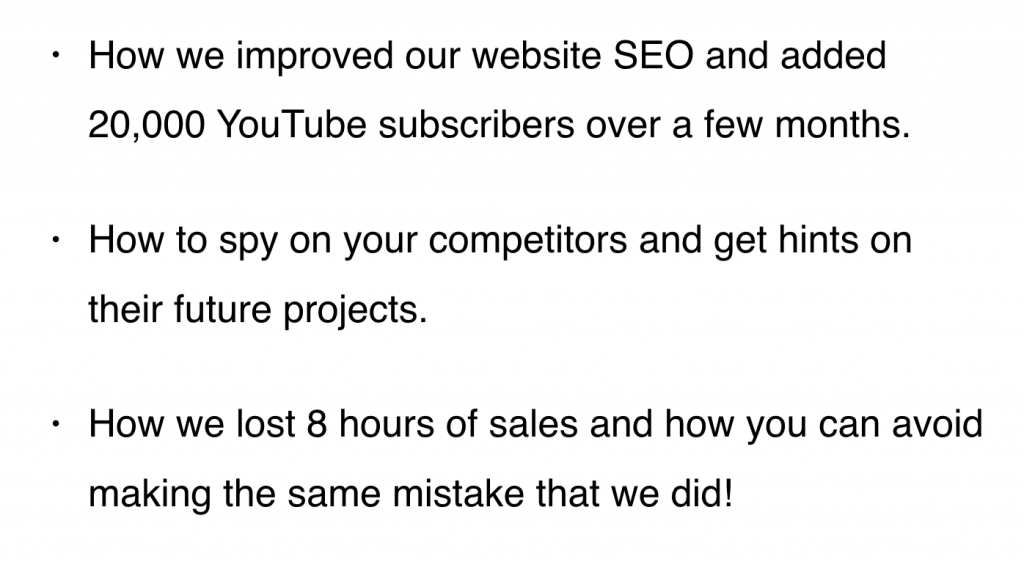
Tip #1: You all know SEO is pretty important. We believe we’re pretty dang good at it. We get like $8 million worth of traffic for free on our site. And I have a content site called List25, which has like 2.3 million YouTube subscribers and over half a billion video views.
So, we all know embedding videos on a page is really, really important. It lets you double dip and increase your time spent on page.

So what we started doing is on one of our sites called WPBeginner, we started taking our popular tutorials and turning them into short videos. And then we started taking two spots on Google.
Now if you don’t have that bandwidth, you still should be embedding other people’s videos. So I built a little tool to capitalize on that. So any time you embed a video in WordPress, it basically adds a little bar. It gives others your video or somebody else’s video. It still says, “Subscribe to your channel.” And we basically had over 20,000 subscribers in a few months.
So I shared this plugin with War Room people, I think two War Rooms ago, and several people loved it, and then I was like, “OK, you can download it there. So you can embed it on your page and increase time spent on site.”
How to find your competitor’s future plans with DNSTrails: This is a very, very neat domain spy tool. We’re using it to find historical DNS data so we can reach out and buy domains.
This is a big part of our strategy in 2018, instead of just buying backlinks and buying traffic. We’re just going out and buying websites outright.
That’s something we started doing in 2017, and we are going to make it a big focus of ours.
So in DNSTrails, type in any domain, for example, DigitalMarketer, and it will tell you all the little things that they’re working on because that’s the first thing you do if you ever come up with an idea. You get a domain or a subdomain.
So you can see all of the subdomains they have.
Then you can see Ryan has 256 other domains, and their office has like 310 domains.
You can go look through all of the domains that they have, and then if you want to buy one of them, you can reach out to them.
Use this to spy on your competitors and find historical data so that you can buy stuff. And now we have rules of privacy, so we can turn it on so people don’t contact us. Well, most people don’t do that right away because this has historical data so you can still find the person’s personal email.
So everybody have a website uptime tracker? We track whether our website is down. But what if your website is up but your leads form is down or your cart is down? This happened to us. This is the Wicked Stupid mistake. You never experience this kind of thing unless you do it, and then you fall and you’re like, “Oh, I need to watch out for this.”
So while our website was up, our cart went down in the middle of night. Nobody knew it. We lost eight hours of sales while still doing ad spend.
Really cool tool: Pingdom. They have transaction monitoring. If you have an ecommerce site, or if you’re doing a lead-gen business, you need to be
checking your cart every two minutes to make sure that it’s always up because sometimes your cart might be down and your website is up, and you have no idea, and you’re wasting money.
Stephen Esketzis
A bit about me. So we run a company called the Media Property Collective. We build media properties, big authority content sites up, and I guess this kind of stems from that. This is a bit of a separate business, but I think you’ll get a lot out of it.
So we’re talking about how to build the viral bot and actually get it to explode on minimum ad spend and how we can actually scale this up.
So what we’ve done is you can get thousands and thousands of leads simply through Facebook bot. And Facebook bot is something that I really like.
These are some of the results we achieved through this Wicked Smart: 10,000 subscribers for a weight loss company and booked out a car detailing company. The agencies I’ve worked with and shown this to have absolutely had phenomenal results.
So it’s something you can implement, whether you’re an e-comm, whether you’re an agency, whether you’re in lead generation, whatever it might be, it can work really well.
The next thing is open rate. Why Messenger bots? The open rate right now in email is quite low, especially if you’re a really a bad email marketer, like myself. Facebook bots are real easy. It feels like you’re just talking to someone. It’s super smooth. It feels like you’re just in a conversation one-on – one. So it’s really comfortable.
So the goals for this are to get lots of Messenger subscribers and sell stuff. Pretty much the same goals we have with leads and conversions.
This is kind of running through the funnel, and then I’ll show you some examples. The first thing we did here was we ran a competition.
Make the Prize Amazing – You have to have a really, really good offer, and I’ll show you what a good offer is and I’ll explain the difference between a weak offer and good offer because it does make a huge difference in terms of the Messenger bot subscribers you start to get.
Make it a Broad Offer – Make it appeal to the mass market. You might be within a niche, but let’s say you’re Paleo, for example. Make it appeal to the wider health community, perhaps. This is what we’ve seen get better results for us.
Make it Relevant
Run it as a Facebook Post – Not an ad, but a post.
Comment to Enter – We use a tool to have a comment to enter a competition.
What typically happens is whenever you get a comment on a post, they get added as a subscriber into your list on your Messenger bot so then you can follow up with them in the future. So a bot picks this up.
You can choose a keyword. You might want the word “win” in there or “subscribe” or the name of your prize or whatever it is. Make it really simple. You want it to be a no-brainer, something everyone can spell. Don’t make it 15 words long. Make it super simple so that way you can implement it, and you start getting virality really quick.
So it subscribes them to your ManyChat lists or your Opesta list, which is another great tool that does Facebook bots. Then it confirms their entry.
Then We Send it Viral – And that’s the really fun part because, as you send it viral, you’re all of a sudden getting this huge engagement with people that you don’t even know, and it just keeps spiraling out of control. So if you’re targeting the right people and your offer is strong, it can just go and go and go, and that’s the really exciting part.
This is how we did it with a car detailing company. So the first thing we wanted to do is get attention. So you can see that we use emojis, emoticons, whatever they’re called, right at the top there. We’re instantly bringing attention to the post, and we’re making it engaging.
We’re not really doing a long-winded, long-form Facebook ad. We want to keep it short, sharp, engaging, fun because Facebook bots are a conversation. So when we’re writing these ads and you’re doing your copy, you want to make it a conversational piece, something people can engage with, have fun with, and get involved with.
So explain the competition in your title with your caption, and then comment to enter and win. So we used “win.” That was a pretty easy one. So you can see this example was a car detailing company. So what happened was we did a quick before and after, explained the details, and then it was a call-to- action to get them involved.
So you confirm your subscription into the bot. So you go, “Hey, first name, just needed to confirm that you wanted to enter the competition. Just reply ‘yes’ and you’ll be entered.” I think Cole had a really good example before in terms of making sure you want to confirm your subscription. I actually like his better, so I might steal that. It was really good. But, confirm the subscription. Make it a super no-brainer in terms of getting them involved in the bot and use a simple-to-post keyword or phrase.
So like you said before, whether it’s “win” or “yes” or “fun” or “competition,” whatever it is, make it super simple. Again, we want to reduce the friction. We want to have the micro-commitments there so that way they keep following through. We’re kind of gamifying the experience.
But you also want to make sure the friction is really low. So there are the two tools there. There’s ManyChat and Opesta. Both phenomenal Facebook tools that you can look up and check out.
So reply and be entertaining. Make the conversation look somewhat human. One thing that I see all the time that’s reduced the close rates or increased the open rates has been using GIFs. GIFs are really easy to use. It appeals to the mass market. You don’t want to be boring in these chat conversations.
You want to make sure you’re entertaining, keeping people involved.
Another really cool thing you can do is add typing, so you can show as if you’re typing and the conversation is real. Some people, depending what audience, might think you’re actually in the real conversation and there’s real people.
So virality is huge. Wait two minutes and then add, “Almost forgot to tell you. Tag friends in the post to increase your chances of winning. For every friend that you tag, you get an extra entry.”
Now, I know Facebook’s been a bit funny with the algorithms lately, so sometimes you want to include this in the actual conversation in the bot. Other times you might want to mention it in your image or in the caption of the actual post. Either works. And then you have the link to the post. You can see the click-through rates have been pretty good.
So what happens is let’s say you’ve got a competition going, and you’ve had a $500 competition. You’ve had all these people subscribe to your bot. You’ve got them. You’ve been talking to them. They’ve been tagging their friends. The thing’s going wild. It’s blowing up.
The next thing is to choose a winner. What I tend to do is I use a randomly generated number or some sort of random generated coupon code or something like that, so you’re pulling something out of a hat. We pick a winner, and then what we’ll do is we’ll award the winner.
For the people who didn’t win, we’ll say, “Unfortunately, you haven’t won this time. However, to compensate, we’ve got a coupon code that can give you 10, 20, 30, 40 percent off whatever it is.” Give them that second chance prize.
And that is where the magic lies. It’s in that second chance opportunity to work with you. And that’s where we found so many people start engaging, whether they buy right now or not, they’ll come down the road, and we’ve opened up that conversation. We’ve got the lead. We’ve got a lot of Internet sales. We have had people had a great experience on the bot.
We’ve had a lot of press, impressions, the whole lot.
So make it exclusive. Make it really good offer as well. This is what I was saying – weak offer versus good offer. This is what’s going to happen with your conversions at that point.
So beyond that, quick recap. We’ve got the competition, comment to enter. We get them to tag a friend, which is really important. Use a strong offer, it goes viral, and then we go through that.

These were some of the quick results. We’ve had some amazing click- through rates. It’s a great success, in terms of sales and leads.
And this was another great example that was done through a friend of mine with their agency, and it’s for an e-commerce product. They did a giveaway with a free blanket, and the value’s really solid. I think this was a video ad as well. You can use video ads. It really depends.
Amanda Dobson
I run our marketing department over at Plattr Media Group. So at any given time, I’m working on any one of our roughly 10 brands. So that’s any market, anywhere from home and fashion to sewing and homesteading all the way to guns and tactical gear and survival. I’m my grandpa’s favorite person right now because I know everything about guns. I know all about tactical gear, so I’m number one in the family right now.
So what I’ve been really good at over the last couple years is finding tools that allow me to work smarter instead of work harder. Trying to get a lot done in a very short amount of time. So I’ve kind of become a slacker, but in a good way. I always find the easiest, fastest way.
So what I want to share with you guys is a tool that I discovered at the end of 2017 that doubled our Pinterest power in less than 90 days, so that means our reach, our clicks, and our impressions.
What would you do if you could get two times the amount of people that were seeing your blog or your site from Pinterest without ever really having to do any extra work? It’d be amazing, right?
We’re using this on Survival Life, make-up tutorials, Sewing.com, homemade recipes. So we’re using for quite a few brands. And this $20 tool, this tool cost us $20 a month and last month that brought us in 56,000 unique new organic visitors on just one of our brands alone. And just to give you an idea of what that impact is…
So I know from my metrics that I make about five cents for every time someone views one of our pages on our blogs. If one of those page views ends up turning into an opt-in, I’m closer to about $2. So when I’m bringing in 56,000 new leads from a platform like Pinterest, where I’m not doing
any promotions, this is all organic. This $20 tool allows me to bring in just shy of $3,000 on a blog without having to lift a finger.
So that tool that I’m using is called BoardBooster. There’s a few other integrations into Pinterest that you can use, but BoardBooster’s been kind of the one that made a big difference for us. We’ve tried a few other ones.
The reason it’s a little bit different are two things:
- BoardBooster has a pin looping option, so basically you can set how often it re-pins a specific pin. We have some pins that typically do better than others, so within that board, we’re using the pin-looping feature to re-pin that multiple times, and it’s all automated so we can choose how often its pinned and where.
- BoardBooster has Pin Doctor – You choose what pins you want to review, what boards you want it review, what campaigns you want it to review, and basically it shows you where your broken links are. It shows you where things don’t quite match content-wise or where there are redirects that are maybe broken. So it basically does all of the work for you. This basically eliminated an entire position for It does all of the hard work for you.
I just wanted to give you an example of the kind of traffic that we’re seeing in BoardBooster right now. So those are some pretty big numbers, and keep in mind, those metrics that I showed you a little bit earlier on how much money we’re making for a page view and for an opt-in.
So this is some of the stats that we’ve seen. We implemented this in the beginning of November. So if you’re looking, we can see the reach has gone from 6 million to 11 million, and this is just one of our sites. And from there we’re seeing 15,000. You’ll notice that clicks is for per week, so that’s where that 56,000 clicks came in and then 14,000 visitors.
So, what you’ll notice is all of those metrics increased, but the amount of posts that I’m actually doing, or the repins that I’m doing is still 200 a day. That didn’t change. So all of those other metrics, that’s literally just BoardBooster doing the work for me.
So I’m not doing any extra work. I’m not producing any extra content. I’m not promoting any pins. I didn’t do anything. I just set up the integration and I followed the instructions, and this is what happened. So you know what? It’s really important. I know that it seems simple because it’s just a tool, but this is what we mean and we talk about this at Wicked Smart all the time. We found a tool that does twice the work in half the time, and you’ve seen that this costs us $20 a month, and we’re bringing in, on this site alone, just shy of
$3,000. So, the ROI is there if you know how to use the tools correctly.

